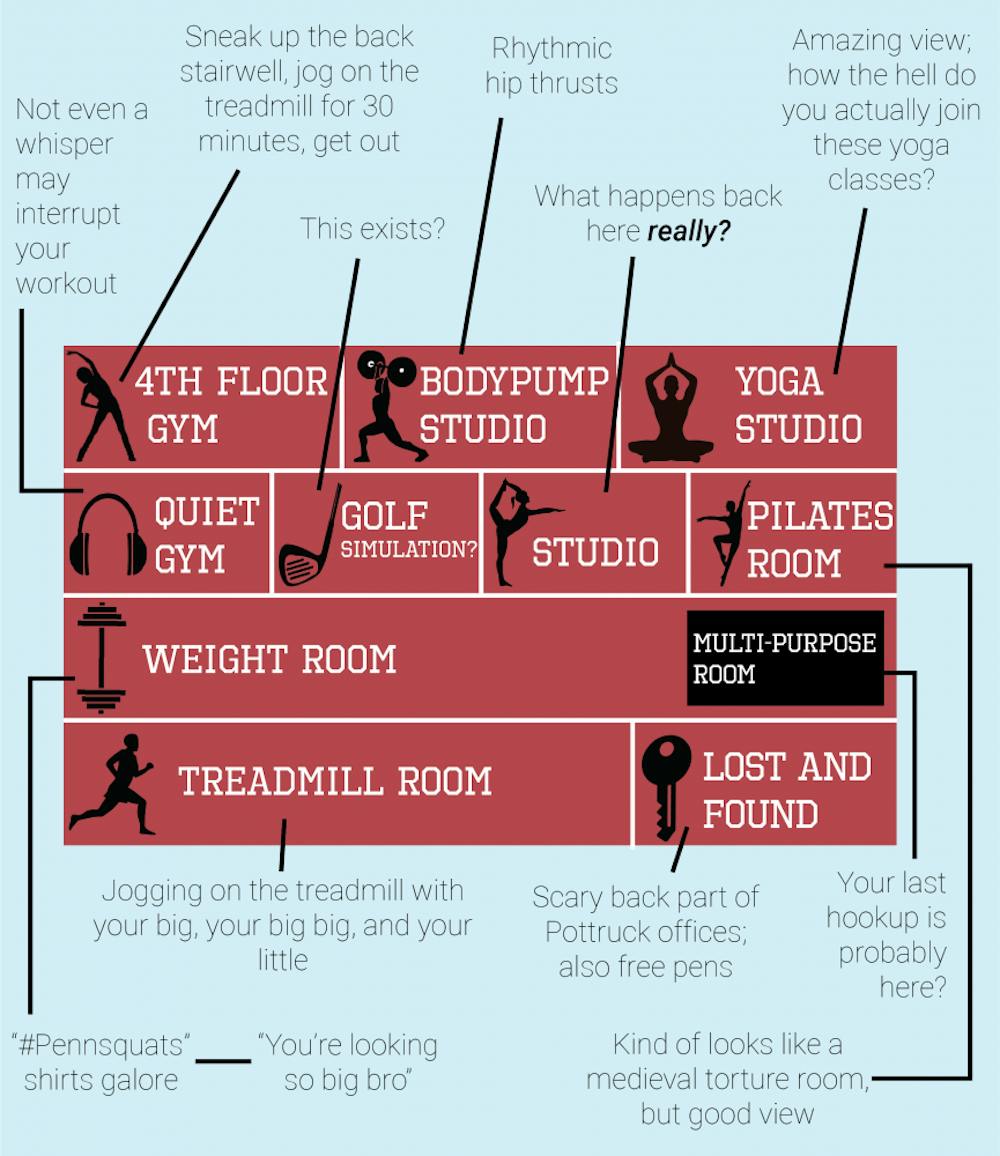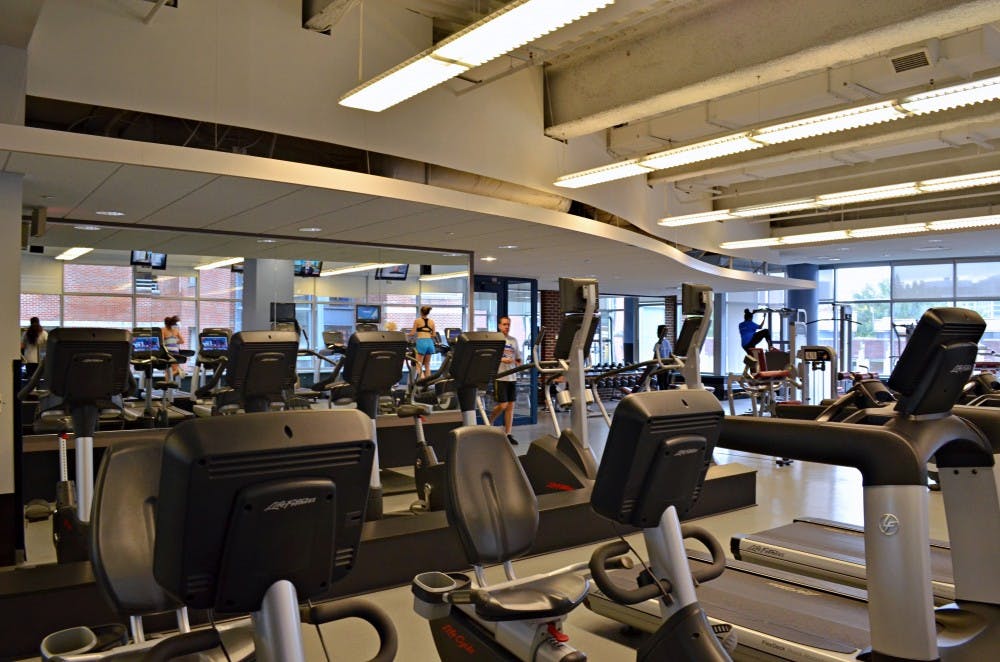When walking down Walnut Street, one invariably sees Lululemon, Adidas, and Nike–clad bodies in blacks, blues, pinks, and greys running in unison on treadmills through the windows of Pottruck Health and Fitness Center.When you enter this athletic sanctuary, the clacking of weights strikes your eardrums. Fit, unimpressed men and women scurry past you—off to their workouts. Feet sprinting on treadmills create a harmonized echo.
Here's the catch about confidence at Pottruck: it matters who you are and what floor you're on.
Some, like Graham Michelson (C '22), look forward to working out at Pottruck almost every day. When asked if he ever felt insecure at the gym, he immediately states, “Oh, no. I love it. I feel so confident in my body, and I like it when everyone can see my gains.”
“Some days I like it if I’m the biggest guy in the gym, it’s pretty nice. But other days, when that’s not the case, I wish I was by myself.” But even Graham, who considers himself fairly confident, still feels inferior among other Pottruck frequenters who are “bigger” than him.
Jennifer Jaffe (C '22) agrees with Graham. Her workouts are more enjoyable if she feels confident in her appearance. “If I were in shape, I’d want guys or cool girls to see me at the gym.” It’s "hot” to be good at working out, Jennifer concludes.

For some, Pottruck is genuinely a place of positivity, and it's undeniable that it's an important resource on campus. It's fitness for (mostly) free.
However, Eliana Margherio (W '21) disagrees with Graham and Jennifer—she doesn’t like to see anyone she knows, regardless of how confident she feels with herself: “I hate that place with a passion,” Eliana says. “Seeing all the people I know at the gym is not what I want during my workout. The gym is hard enough as it is and dealing with awkward encounters adds a whole other layer to it,” she admits.
Jennifer adds that knowing different people at Pottruck can affect where she works out, how she works out, and how she feels about it. She says that it can both be motivating and discouraging, reflecting that “When I see people I know, it’s more fun to go.’ But then other times, I’m like, ‘Hm, I don’t want everyone to see me struggling. I’d rather just find a space to clear my head. But I go back and forth.’”
Each floor of Pottruck lends itself to its own brand of insecurities. However, one floor stands out amongst the rest. The second floor of Pottruck houses what many people fear and avoid due to its overwhelming masculine attendance: the weight room.
Graham reflects that in the weight room, “men [are] flexing in the mirror, trying to look huge, wanting to look big.” Some people admit that when they feel they are being watched, they feel the need to perform better in the gym. Flexing, which Jennifer describes as, “showing off in front of others to be perceived as cool or good at something,” seems to be a social driver behind performance at the gym for both young men and women. And this performance is largely found on floor two.
Jennifer refuses to step foot inside Pottruck’s weight room. “I’m so scared. I look in, and it’s all frat boys, and I’m like ‘no.’ I’m too scared even to look inside,” she insists. Jennifer’s fear sparks from a lack of belonging, she explains. “I feel like I would be looked at for many reasons. One, I look very out of place. I’m not very muscular. Two, it’s a whole room of boys. A girl automatically, by natural forces, gets looked at,” she concludes.
And the wall–to–wall mirrors don’t help—it’s impossible not to look at yourself and your surroundings when in the weight room. “When you’re weightlifting, it’s more of a performance, there are mirrors everywhere, and you can really see each other. It’s a much more open space, and the levels of experience are much more evident,” Graham explains.

The norm is that: “Girls don’t want to be ‘yoked,’ they want to be toned and slim, hence cardio. But boys, they talk about not wanting to get small, so they lift,” Jennifer reflects.
Graham's response is almost equivalent to Jennifer's: “I associate cardio and yoga with girls, and I associate lifting with guys. It’s a societal, cultural standard that guys want to be big and toned, and girls want to be skinnier, curvier, and flexible.”
These different physical expectations limit people of all genders to working out in one specific place—or not working out at all. Ancient gender stereotypes almost seem to have designed the blueprint for Pottruck's physical layout. Graham sees this limiting dynamic play out in his guy friends who want to do cardio, but refuse to go to the first floor because “most girls go there.”
For many people, the gym is an escape or a way to feel better about themselves—but unfortunately, the social and physical divides of our campus gym seem to inhibit these benefits. In a gym outlined by its gender barriers, it can be hard to find the motivation or the courage to a space dedicated to fitness; however, on a campus that's so seemingly liberal, perhaps we should be trying to find ways to break these cultural barriers instead of conforming to them.

